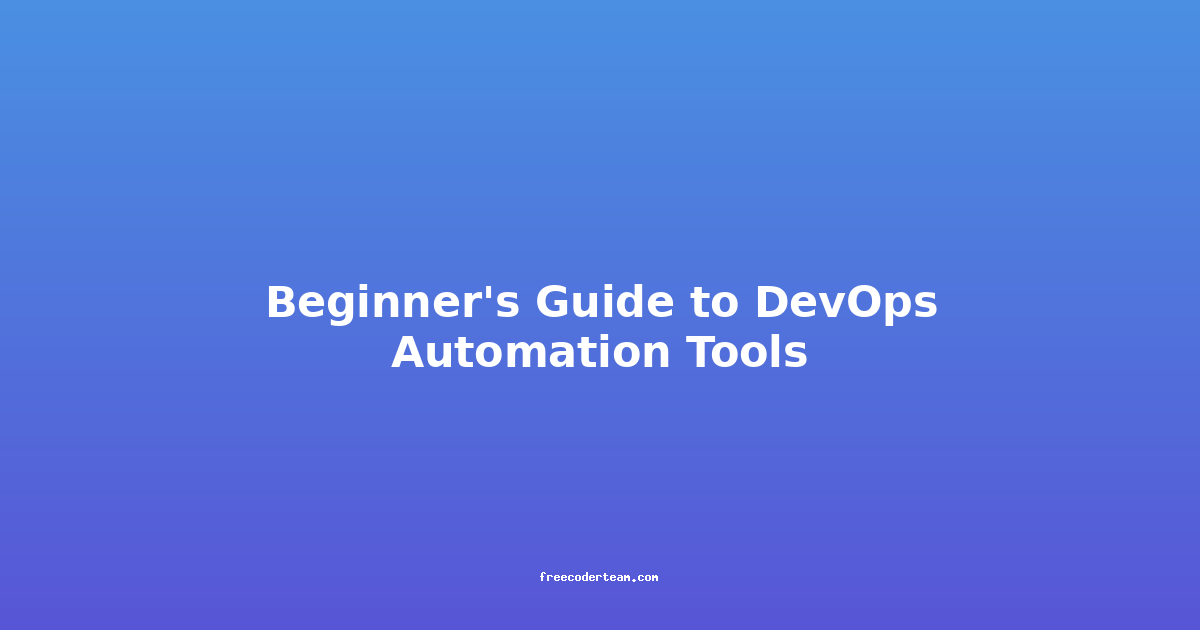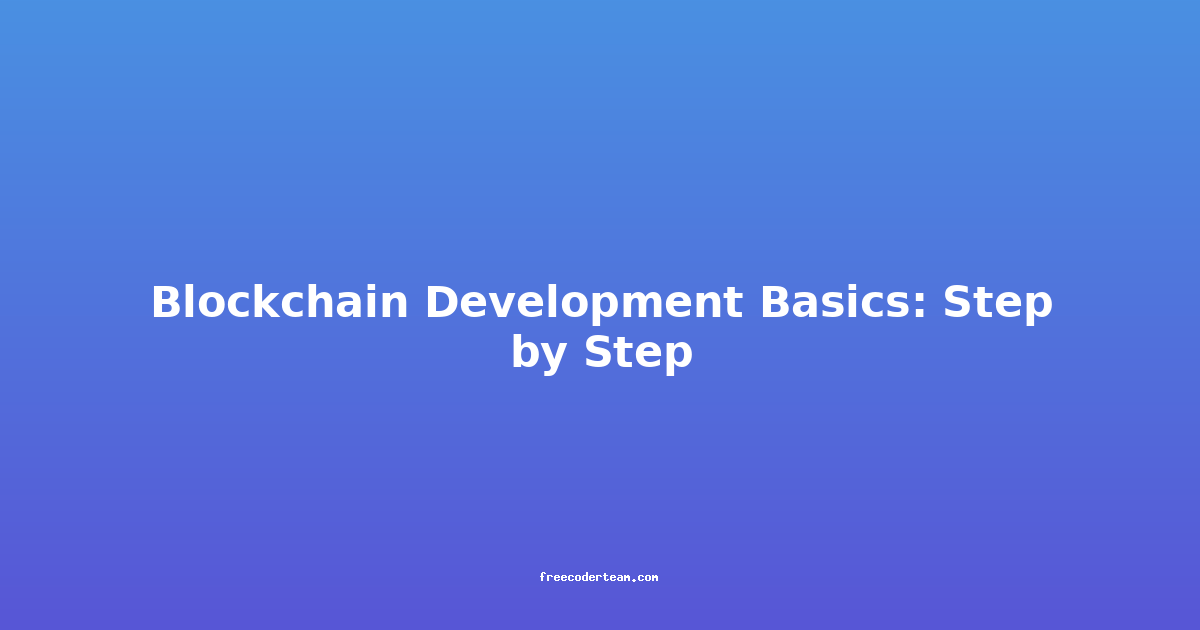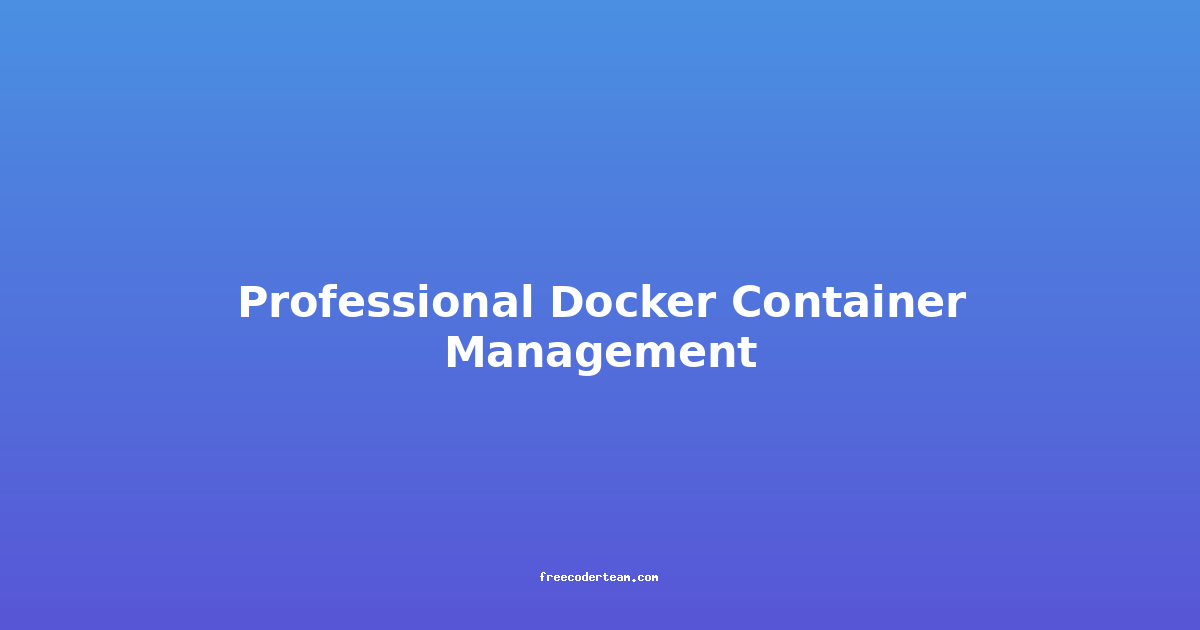Beginner's Guide to DevOps Automation Tools
DevOps is all about improving the efficiency and collaboration between development and operations teams. Automation plays a crucial role in achieving this by streamlining processes, reducing manual effort, and ensuring consistency. In this beginner's guide, we'll explore some of the most popular DevOps automation tools, their use cases, and best practices to help you get started.
Table of Contents
- What is DevOps Automation?
- Why Automate DevOps Processes?
- Key DevOps Automation Tools
- Best Practices for DevOps Automation
- Actionable Insights and Practical Examples
- Conclusion
What is DevOps Automation?
DevOps automation refers to the use of tools and technologies to automate repetitive, time-consuming, or error-prone tasks in the software development lifecycle. This includes tasks such as building, testing, deploying, and monitoring applications. By automating these processes, teams can reduce manual intervention, increase speed, and ensure consistency.
Why Automate DevOps Processes?
- Speed and Efficiency: Automation accelerates the software delivery process, reducing the time it takes to go from code commit to production.
- Reduced Human Error: Manual processes are prone to errors, while automation ensures consistency and accuracy.
- Scalability: Automation tools can handle tasks at any scale, making it easier to manage large and complex systems.
- Cost-Effective: By reducing the need for manual intervention, organizations can save on labor costs and resources.
- Consistency: Automated workflows ensure that processes are executed the same way every time, leading to predictable outcomes.
Key DevOps Automation Tools
1. Jenkins
Jenkins is one of the most widely used automation servers for CI/CD pipelines. It is open-source and highly extensible, allowing developers to integrate various tools and plugins.
Features:
- CI/CD Pipelines: Jenkins can automate the build, test, and deployment phases of software development.
- Extensibility: With over 1,000 plugins, Jenkins can be customized to suit almost any workflow.
- Cross-Platform Support: Jenkins runs on Linux, Windows, and macOS.
Example: Setting Up a Basic Jenkins Pipeline
pipeline {
agent any
stages {
stage('Build') {
steps {
echo 'Building the project...'
// Example: Compile the code
sh 'mvn clean install'
}
}
stage('Test') {
steps {
echo 'Running tests...'
// Example: Run unit tests
sh 'mvn test'
}
}
stage('Deploy') {
steps {
echo 'Deploying the application...'
// Example: Deploy to a test server
sh 'scp target/myapp.jar deploy@myserver:/app'
}
}
}
}
Best Practices:
- Use declarative pipelines for better readability and maintainability.
- Implement version control for your Jenkins configurations to track changes.
- Use Jenkins plugins to integrate with other tools like Docker, Kubernetes, and AWS.
2. Ansible
Ansible is a powerful configuration management tool that simplifies provisioning, deployment, and orchestration. It is agentless, meaning it doesn't require an agent on remote machines.
Features:
- Agentless Architecture: Ansible uses SSH to connect to remote machines, making it easy to deploy.
- Playbooks: Ansible uses YAML-based playbooks to define tasks, making it easy to read and maintain.
- Idempotency: Ansible ensures that tasks are executed only if necessary, preventing unnecessary changes.
Example: Creating an Ansible Playbook for Web Server Deployment
---
- name: Deploy a web server
hosts: webservers
become: yes
tasks:
- name: Ensure Apache is installed
ansible.builtin.package:
name: httpd
state: present
- name: Start and enable Apache
ansible.builtin.service:
name: httpd
state: started
enabled: yes
- name: Copy index.html to web root
ansible.builtin.copy:
src: /path/to/index.html
dest: /var/www/html/index.html
Best Practices:
- Define clear roles and tasks to modularize your playbooks.
- Use variables and templates for dynamic configuration.
- Version control your playbooks and inventory files.
3. Terraform
Terraform is an infrastructure-as-code (IaC) tool that allows you to define and provision cloud infrastructure using a declarative language. It supports multiple cloud providers, including AWS, Azure, and Google Cloud.
Features:
- Declarative Configuration: Terraform uses a simple JSON-like language (HCL) to define infrastructure.
- State Management: Terraform maintains a state file to track changes and ensure idempotency.
- Provider Support: Supports multiple cloud providers and on-premises infrastructure.
Example: Creating an AWS EC2 Instance with Terraform
provider "aws" {
region = "us-west-2"
}
resource "aws_instance" "example" {
ami = "ami-0c55b159cbfafe1f0"
instance_type = "t2.micro"
tags = {
Name = "example"
}
}
Best Practices:
- Use version control for your Terraform configuration files.
- Implement a change management process for infrastructure changes.
- Regularly destroy and recreate resources to ensure your configuration is correct.
4. Docker
Docker is a containerization platform that allows developers to package applications and their dependencies into lightweight, portable containers. This ensures consistency across development, testing, and production environments.
Features:
- Containerization: Docker containers provide a consistent environment for applications.
- Docker Compose: Simplifies multi-container applications.
- Docker Hub: A registry for storing and sharing Docker images.
Example: Dockerfile for a Python Application
# Use an official Python runtime as a parent image
FROM python:3.8-slim
# Set the working directory in the container
WORKDIR /app
# Copy the current directory contents into the container at /app
COPY . /app
# Install any needed packages specified in requirements.txt
RUN pip install --no-cache-dir -r requirements.txt
# Make port 80 available to the world outside this container
EXPOSE 80
# Define environment variable
ENV NAME World
# Run app.py when the container launches
CMD ["python", "app.py"]
Best Practices:
- Use multi-stage builds to reduce image size.
- Keep Docker images lean by minimizing layers and using official base images.
- Automate the build and push process using CI/CD tools like Jenkins or GitHub Actions.
5. GitHub Actions
GitHub Actions is a native CI/CD platform integrated into GitHub. It allows you to automate workflows directly within your repositories using YAML-based configurations.
Features:
- Native to GitHub: No need for external servers or agents.
- Simple Workflow: Define workflows using YAML files.
- Community Actions: Access a wide range of pre-built actions from the community.
Example: GitHub Actions Workflow for Building and Testing a Python Project
name: Python unittests
on: [push]
jobs:
build:
runs-on: ubuntu-latest
steps:
- uses: actions/checkout@v3
- name: Set up Python
uses: actions/setup-python@v3
with:
python-version: '3.8'
- name: Install dependencies
run: |
python -m pip install --upgrade pip
pip install -r requirements.txt
- name: Test with unittest
run: |
python -m unittest discover
Best Practices:
- Use reusable workflows and actions wherever possible.
- Automate pull request workflows to ensure code quality.
- Monitor and log workflow executions for debugging.
Best Practices for DevOps Automation
- Version Control: Keep all automation scripts, configuration files, and code in version control systems like Git.
- Continuous Integration: Automate build and test processes to catch issues early.
- Pipeline as Code: Define your CI/CD pipelines in code to ensure consistency and reproducibility.
- Monitoring and Logging: Implement monitoring and logging to track the health and performance of your automation pipelines.
- Security: Use secure practices for credential management and access control.
Actionable Insights and Practical Examples
- Start Small: Begin with automating simple tasks like building and testing. As you gain confidence, move on to more complex processes like deployment and infrastructure provisioning.
- Use Templates: Leverage templates and examples from the community to get started quickly. Many tools provide starter workflows and configurations.
- Test Regularly: Automate testing at every stage of the pipeline to ensure that changes do not break existing functionality.
- Collaborate: Involve both development and operations teams in the automation process to ensure that the solutions meet all requirements.
Conclusion
DevOps automation is a powerful approach to streamlining software delivery and improving collaboration between teams. By leveraging tools like Jenkins, Ansible, Terraform, Docker, and GitHub Actions, organizations can achieve faster, more reliable, and more efficient processes.
As a beginner, start by understanding the basics of each tool and gradually build your skills by applying them to real-world scenarios. Remember to follow best practices, such as version control and monitoring, to ensure the success of your automation efforts.
With the right tools and approach, DevOps automation can transform your development and deployment processes, leading to smoother operations and faster time-to-market. Happy automating! 🚀
References:




